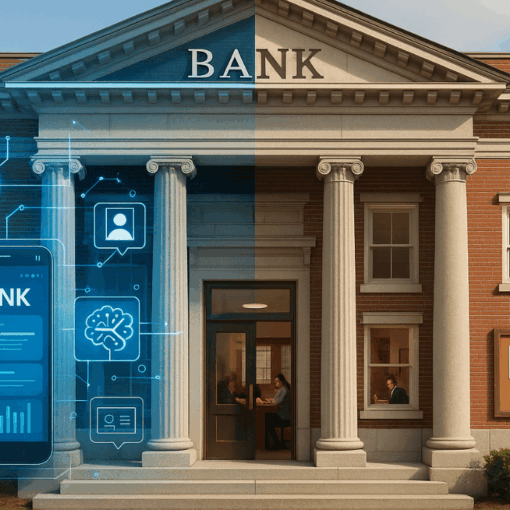Custom middleware and API integrations between legacy systems isn’t exactly something bankers dream about. It sounds like backend plumbing, and honestly, it is. But when you’ve got legacy tech in one corner and modern tools in another, and nothing connecting them, it’s the plumbing that either keeps things flowing or brings the whole operation to a crawl.
For most community banks, “legacy” isn’t a bad word. It usually means systems that are stable, familiar, and fully paid off. The real challenge is that those systems weren’t built to connect with the newer platforms banks are now layering in, like CRMs, data dashboards, or AI tools. So what happens? Your team ends up doing the same work in two or three different systems, retyping data, rechecking spreadsheets, and spending time keeping everything in sync manually.
You don’t need a whole new core. You just need a smarter way to make the systems talk to each other.
Bridging the Gap, Quietly and Powerfully
Imagine you’ve got a 15-year-old loan origination system that still works fine. It’s not fast, and it’s not flashy, but it gets the job done. Now, say your marketing team starts using a modern CRM. Suddenly, they want real-time customer insights. Leadership wants pipeline data on demand. And your credit team wants to see borrower activity without digging through multiple systems.
But the old LOS? It’s not sharing anything unless someone exports a CSV and sends it around manually.
That’s where custom middleware steps in, not to replace the LOS, but to translate what it’s saying and send that data where it’s needed. It acts like an interpreter between old and new, shuttling information back and forth in the background so your people don’t have to.
There’s no giant overhaul. No “big bang” system migration. Just one quiet connection that unlocks a better workflow.
Goodbye Double Entry, Hello Sanity
One of the fastest ways to kill efficiency is to ask staff to enter the same information in multiple places. And yet, that’s exactly what happens when platforms don’t connect. A customer updates their address, and suddenly someone has to make the change in three different databases.
That kind of redundancy isn’t just tedious, it’s risky. A single mismatch can derail a loan, delay compliance reviews, or lead to embarrassing customer service slip-ups.
By using middleware to create real-time communication between systems, banks can eliminate those repetitive tasks and the human error that comes with them. That one-time address update? It reflects across every system without a single copy-paste.
And here’s where that list makes sense, because it helps show exactly what middleware enables when done right:
- Live syncing between legacy cores and modern CRMs
- Seamless data sharing from loan systems to compliance tools
- Automated population of reporting dashboards
- Elimination of manual imports, exports, and rekeying
- Clearer visibility across departments, with no extra clicks
It’s not fancy. It’s not flashy. But it makes the tech stack feel modern, even if the core isn’t.
Integration Without the Drama
The beauty of this approach is that it doesn’t demand an all-or-nothing commitment. Middleware wraps around your current systems. It respects what’s already working and simply gives it more reach.
Rather than asking your staff to change everything overnight, you can make small, smart integrations, one connection at a time. Maybe you start with syncing data from your LOS to your CRM. Maybe it’s piping information into a real-time reporting tool. Each success builds momentum, proving to your team that modernization doesn’t have to come with disruption.
And unlike massive system overhauls, these integrations don’t require lengthy training, heavy onboarding, or weekend cutovers. It’s modernization at a pace your team can actually handle.
What Middleware Doesn’t Do (And That’s Fine)
Now, just to set expectations, it’s not a magic wand. If a system is broken or lacks key functionality, middleware won’t invent features out of thin air. What it will do is bridge the gap between platforms that already do their jobs well, just not in sync with each other.
The point isn’t to stretch your tech past its limits. It’s to unlock more value from what you already own, and buy time to plan bigger moves down the line, if and when they’re needed.
If You’re Asking “Should We Replace It?” Try Asking This Instead
A lot of banks feel cornered when a legacy system starts holding them back. The reflex is to start shopping for replacements. But replacing a system, especially one as central as a core or LOS, is a massive undertaking. Expensive. Stressful. Full of risk.
Before you go there, ask this instead: Can we get what we need by connecting what we already have?
Middleware might not solve every problem. But it often solves the ones that actually affect your staff and customers the most, without touching the foundation you’ve already built.
TL;DR: Make Old Systems Work Like They Belong in 2025
Custom middleware and API integrations between legacy systems give community banks a way to modernize operations without tossing out what’s already working. It’s the missing link between dependable old systems and the new tools your team actually wants to use.
You don’t need to rip and replace. You just need a smarter way to connect the dots. Want help figuring out where a simple integration could unlock real impact? Contact us and we’ll help map it out.





